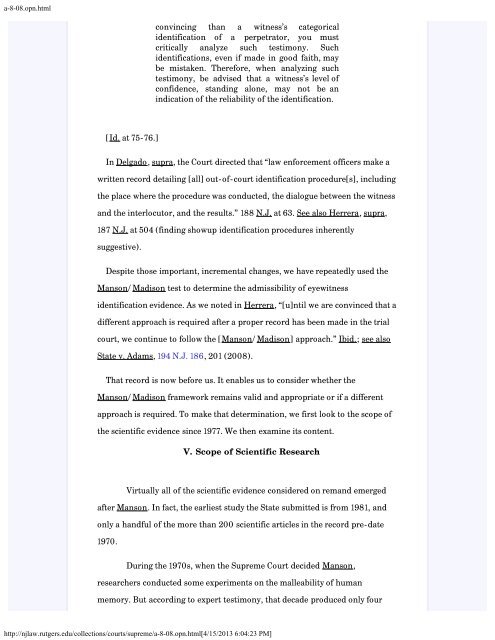State v. Henderson and the New Model Jury Charges - New Jersey ...
State v. Henderson and the New Model Jury Charges - New Jersey ...
State v. Henderson and the New Model Jury Charges - New Jersey ...
You also want an ePaper? Increase the reach of your titles
YUMPU automatically turns print PDFs into web optimized ePapers that Google loves.
a-8-08.opn.html<br />
convincing than a witness’s categorical<br />
identification of a perpetrator, you must<br />
critically analyze such testimony. Such<br />
identifications, even if made in good faith, may<br />
be mistaken. Therefore, when analyzing such<br />
testimony, be advised that a witness’s level of<br />
confidence, st<strong>and</strong>ing alone, may not be an<br />
indication of <strong>the</strong> reliability of <strong>the</strong> identification.<br />
[Id. at 75-76.]<br />
In Delgado, supra, <strong>the</strong> Court directed that “law enforcement officers make a<br />
written record detailing [all] out-of-court identification procedure[s], including<br />
<strong>the</strong> place where <strong>the</strong> procedure was conducted, <strong>the</strong> dialogue between <strong>the</strong> witness<br />
<strong>and</strong> <strong>the</strong> interlocutor, <strong>and</strong> <strong>the</strong> results.” 188 N.J. at 63. See also Herrera, supra,<br />
187 N.J. at 504 (finding showup identification procedures inherently<br />
suggestive).<br />
Despite those important, incremental changes, we have repeatedly used <strong>the</strong><br />
Manson/Madison test to determine <strong>the</strong> admissibility of eyewitness<br />
identification evidence. As we noted in Herrera, “[u]ntil we are convinced that a<br />
different approach is required after a proper record has been made in <strong>the</strong> trial<br />
court, we continue to follow <strong>the</strong> [Manson/Madison] approach.” Ibid.; see also<br />
<strong>State</strong> v. Adams, 194 N.J. 186, 201 (2008).<br />
That record is now before us. It enables us to consider whe<strong>the</strong>r <strong>the</strong><br />
Manson/Madison framework remains valid <strong>and</strong> appropriate or if a different<br />
approach is required. To make that determination, we first look to <strong>the</strong> scope of<br />
<strong>the</strong> scientific evidence since 1977. We <strong>the</strong>n examine its content.<br />
V. Scope of Scientific Research<br />
Virtually all of <strong>the</strong> scientific evidence considered on rem<strong>and</strong> emerged<br />
after Manson. In fact, <strong>the</strong> earliest study <strong>the</strong> <strong>State</strong> submitted is from 1981, <strong>and</strong><br />
only a h<strong>and</strong>ful of <strong>the</strong> more than 200 scientific articles in <strong>the</strong> record pre-date<br />
1970.<br />
During <strong>the</strong> 1970s, when <strong>the</strong> Supreme Court decided Manson,<br />
researchers conducted some experiments on <strong>the</strong> malleability of human<br />
memory. But according to expert testimony, that decade produced only four<br />
http://njlaw.rutgers.edu/collections/courts/supreme/a-8-08.opn.html[4/15/2013 6:04:23 PM]
















